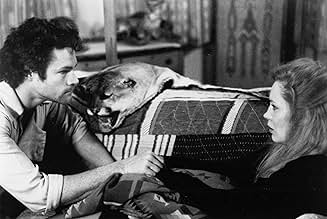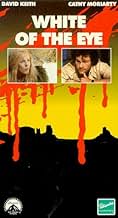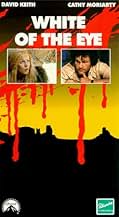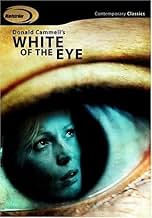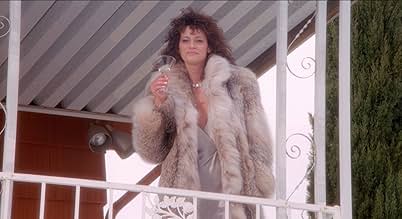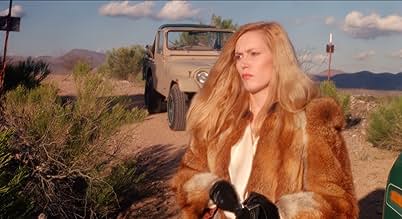CALIFICACIÓN DE IMDb
6.1/10
3.2 k
TU CALIFICACIÓN
Alguien está matando a mujeres casadas ricas en sus casas - la última en una rica comunidad del desierto a las afueras de Tucson. Un experto en sonido casado es el principal sospechoso.Alguien está matando a mujeres casadas ricas en sus casas - la última en una rica comunidad del desierto a las afueras de Tucson. Un experto en sonido casado es el principal sospechoso.Alguien está matando a mujeres casadas ricas en sus casas - la última en una rica comunidad del desierto a las afueras de Tucson. Un experto en sonido casado es el principal sospechoso.
- Dirección
- Guionistas
- Elenco
Pamela Guest
- Caryanne
- (as Pamela Seamon)
China Kong
- Ruby Hoy
- (as China Cammell)
Opiniones destacadas
Only his third film in 17 years, Scottish director Donald Cammell followed his mind and identity-bending psychedelic masterpiece Performance (1968) and the studio-butchered Demon Seed (1977) with another oddity, the strange and confusing, yet nonetheless effortlessly intriguing White of the Eye. Cammell killed himself shortly after seeing his final film, Wild Side (1995), heavily censored by an appalled producer, at the end of what seemed like a frustrating career. It's a shame he wasn't allowed more opportunities to direct features, as although White of the Eye sometimes steers into TV-movie aesthetic and features an unnecessarily overblown climax, it is something to be savoured and thought about a long time after the credits roll.
After a series of brutal murders of upper-class women, tire tracks left by the killer leads Detective Charlie Mendoza (Art Evans) to sound expert Paul White (Keith David). We learn through flashbacks the meeting of Paul and his now-wife Joan (Cathy Moriarty), and how he stole her away from her boyfriend Mike Desantos (Alan Rosenberg). There's something not quite right about Paul - he has the strange ability to omit a sound that echoes through his head, allowing him to hear at what point in a room that the sound from speakers should come from. Mike knows something too, and when Joan discovers Paul's secret affair, she slowly uncovers who her husband really is.
There's not really much point trying to unravel the mysteries in the movie, as it will leave you with a headache. Below the surface of giallo-esque murders and the sleazy Lynchian atmosphere, there seems to be a mythology happening somewhere. At one point, Paul whispers "I am the One,". Is this really a deeper story than it lets on, or is Paul just simply a narcissistic loon? Whatever it is, the film works better if you just let it play out, as the film has a lot to offer in terms of style. The soundtrack, by Rick Fenn and Pink Floyd's Nick Mason, is a powerful presence, and drums up a dusty, apocalyptic feel reminiscent of Richard Stanley's Dust Devil, which came out 5 years later.
David's performance is also impressive, especially in the latter stages when he is let off the leash. But it's about the only good thing about the climax, which tries too hard to be a number of different things and fails in just about every one of them. It becomes almost generic, with car chases and a stalk-and-slash set-piece, completely betraying the slow-build that came before. Whether Cammell was simply trying to appease his producers or indulging in mainstream aspirations, I don't know. Still, this is a bizarre little treat; uncomfortable and distinctive, cementing it's status as a must-see for fans of cult oddities.
www.the-wrath-of-blog.blogspot.com
After a series of brutal murders of upper-class women, tire tracks left by the killer leads Detective Charlie Mendoza (Art Evans) to sound expert Paul White (Keith David). We learn through flashbacks the meeting of Paul and his now-wife Joan (Cathy Moriarty), and how he stole her away from her boyfriend Mike Desantos (Alan Rosenberg). There's something not quite right about Paul - he has the strange ability to omit a sound that echoes through his head, allowing him to hear at what point in a room that the sound from speakers should come from. Mike knows something too, and when Joan discovers Paul's secret affair, she slowly uncovers who her husband really is.
There's not really much point trying to unravel the mysteries in the movie, as it will leave you with a headache. Below the surface of giallo-esque murders and the sleazy Lynchian atmosphere, there seems to be a mythology happening somewhere. At one point, Paul whispers "I am the One,". Is this really a deeper story than it lets on, or is Paul just simply a narcissistic loon? Whatever it is, the film works better if you just let it play out, as the film has a lot to offer in terms of style. The soundtrack, by Rick Fenn and Pink Floyd's Nick Mason, is a powerful presence, and drums up a dusty, apocalyptic feel reminiscent of Richard Stanley's Dust Devil, which came out 5 years later.
David's performance is also impressive, especially in the latter stages when he is let off the leash. But it's about the only good thing about the climax, which tries too hard to be a number of different things and fails in just about every one of them. It becomes almost generic, with car chases and a stalk-and-slash set-piece, completely betraying the slow-build that came before. Whether Cammell was simply trying to appease his producers or indulging in mainstream aspirations, I don't know. Still, this is a bizarre little treat; uncomfortable and distinctive, cementing it's status as a must-see for fans of cult oddities.
www.the-wrath-of-blog.blogspot.com
In the wealthy and isolated desert community of Tucson, a sound expert (David Keith) is targeted as the prime suspect of a series of brutal murders of local suburban housewives who were attacked and mutilated in their homes. Tucson is the perfect home for this killer, as it provides a mix of the "civilized" and the wild.
This is one of those titles that has faded more or less into obscurity. As I understand it, the movie was released in 1987 to critical acclaim but low box office returns, causing it never to get a proper release. At least not until Scream Factory came along and put the film on Blu-ray, along with some special features. (Unfortunately, the director had long since passed.)
The film is beautifully shot, using extensive time to show the landscape and surroundings. This does slow the picture down, which will scare some viewers off, but at least for the first half of the movie, it is more of a work of art than a thriller or horror picture. The artsy shots during the murders (not focused on the murder itself), the classical music... it is quite a feast.
Things go from subdued to bizarre in the second half. Not wanting to give anything away, I cannot even mention the strangest moments. But after the first half, you could never even guess the sort of things you will see. It is like the first half is more or less an attempt to emulate the Italian giallo (we even see nothing of the killer beyond an eye and some gloves). Then it becomes more like what we expect from Cannon Films.
Someone ought to explain what is wrong with the daughter. Is she mentally disabled or just socially awkward? But maybe that is just to contribute more to the strange vibe the film gives off. That unusual casting is contrasted with the return of Cathy Moriarty ("Raging Bull"), who had come back from a five-year acting hiatus following a serious car accident. Audiences today may know her best as the villain in "Casper", but it is great to see her in this more challenging role.
The Scream Factory audio commentary comes from Cammell biographer Sam Umland, who is surprisingly knowledgeable not just on Cammell, but on the various shots of this film and how they may be references to obscure French and Italian films. He finds many subtle hints that may or may not have been intentional, such as the parallels between the plot of the film and the plot of the opera that Paul White sings. We can also learn of the multiple homages to "Peeping Tom", most notably the use of a mirror during murder. Very, very wise decision, Scream.
The disc also comes with two deleted scenes and an interview with the Steadicam operator, Larry McConkey. (Actually, there are other interviews on the disc not listed on the case, which are very much worth your time.) For a film that has been widely forgotten, Scream pulled all the stops and gave this just about as good of a release as anyone could hope for.
This is one of those titles that has faded more or less into obscurity. As I understand it, the movie was released in 1987 to critical acclaim but low box office returns, causing it never to get a proper release. At least not until Scream Factory came along and put the film on Blu-ray, along with some special features. (Unfortunately, the director had long since passed.)
The film is beautifully shot, using extensive time to show the landscape and surroundings. This does slow the picture down, which will scare some viewers off, but at least for the first half of the movie, it is more of a work of art than a thriller or horror picture. The artsy shots during the murders (not focused on the murder itself), the classical music... it is quite a feast.
Things go from subdued to bizarre in the second half. Not wanting to give anything away, I cannot even mention the strangest moments. But after the first half, you could never even guess the sort of things you will see. It is like the first half is more or less an attempt to emulate the Italian giallo (we even see nothing of the killer beyond an eye and some gloves). Then it becomes more like what we expect from Cannon Films.
Someone ought to explain what is wrong with the daughter. Is she mentally disabled or just socially awkward? But maybe that is just to contribute more to the strange vibe the film gives off. That unusual casting is contrasted with the return of Cathy Moriarty ("Raging Bull"), who had come back from a five-year acting hiatus following a serious car accident. Audiences today may know her best as the villain in "Casper", but it is great to see her in this more challenging role.
The Scream Factory audio commentary comes from Cammell biographer Sam Umland, who is surprisingly knowledgeable not just on Cammell, but on the various shots of this film and how they may be references to obscure French and Italian films. He finds many subtle hints that may or may not have been intentional, such as the parallels between the plot of the film and the plot of the opera that Paul White sings. We can also learn of the multiple homages to "Peeping Tom", most notably the use of a mirror during murder. Very, very wise decision, Scream.
The disc also comes with two deleted scenes and an interview with the Steadicam operator, Larry McConkey. (Actually, there are other interviews on the disc not listed on the case, which are very much worth your time.) For a film that has been widely forgotten, Scream pulled all the stops and gave this just about as good of a release as anyone could hope for.
There's a lot going on in this movie, I just look forward to the day I can finally decode it, which doesn't sound like a good sign. There seems to be something vaguly supernatural at the core of it and something about love. On the subconcious level it seems to make sense, I just can't get anywhere when I try to analyse it consiously. For those put off by the accusations of style over substance, have faith, this is an fascinating movie. There's one moment that is absolutly hair-rasing, the moment when we finally realize that Keiths mind is living in a diffirent world. The only thing that lets the film down is the ending, which looks like a Hollywood style tag-on but probably isn't. Once the car chase starts it's time to leave.
Right near the opening, there's a very brutal and stylized murder of a woman (and her goldfish). The police identify an Indian-style compass made out of objects on a counter. This type of compass of colored objects, and an actual compass recur several times throughout the movie, but to what purpose, I don't know.
A man who makes custom sound systems for people lives with his wife and daughter. She had been traveling from New York City to Los Angeles with her boyfriend, but they stopped in Arizona to repair his stereo after she ruined it in a fit of anger. That's when she met the sound guy, and she left her boyfriend for him.
The sound guy's van's treads match those of the killer, though there's at least forty others with the same kind.
The movie is pretty well-made, and well-acted until towards then end when it gets pretty outrageous after the killer is identified. In a real groaner of a scene, someone comes out of nowhere to try to save the day. And then what happens to the killer is downright ridiculous.
I saw this on a pan & scan videotape. Given the director's artistic bent and the Arizona setting, widescreen would definitely be an improvement. Evidently about ten minutes were cut from the film to get an R rating (the MPAA is criminally insane), so perhaps an uncut version would be an improvement. Interesting film, disappointing final reel. Critic Steven Jay Schneider has a long article about the movie and director (see external reviews) that is worth reading.
A man who makes custom sound systems for people lives with his wife and daughter. She had been traveling from New York City to Los Angeles with her boyfriend, but they stopped in Arizona to repair his stereo after she ruined it in a fit of anger. That's when she met the sound guy, and she left her boyfriend for him.
The sound guy's van's treads match those of the killer, though there's at least forty others with the same kind.
The movie is pretty well-made, and well-acted until towards then end when it gets pretty outrageous after the killer is identified. In a real groaner of a scene, someone comes out of nowhere to try to save the day. And then what happens to the killer is downright ridiculous.
I saw this on a pan & scan videotape. Given the director's artistic bent and the Arizona setting, widescreen would definitely be an improvement. Evidently about ten minutes were cut from the film to get an R rating (the MPAA is criminally insane), so perhaps an uncut version would be an improvement. Interesting film, disappointing final reel. Critic Steven Jay Schneider has a long article about the movie and director (see external reviews) that is worth reading.
Shamefully neglected thriller from director Donald Cammell is an outstanding and disturbing character study!
Arizonia family man becomes the chief suspect when some local women are violently murdered, but is this charming man the real killer?
White of the Eye is a bizarre trip of a thriller that's quite unlike any other film of the thriller/horror genre. Director Donald Cammell gives this film such incredible and dazzling style that one almost becomes hypnotized at times. It's a must-see for those who enjoy art house films. Cammell has a terrific talent for inventive cinematography and well uses the parched filming locations of Globe, Arizona. A nicely atmospheric music score also helps to set up the rather primitive-like setting of the film. Cammell also sets up some truly frightening and creative murder sequences. The story, based upon Margaret Tracy's novel Mrs. White, is a strangely compelling mystery with some great turns and taught suspense. Its a well-paced shocker that escalates to tremendous tension and a excellently executed finale.
The films stars are another true highlight. Heroine Cathy Moriarty does a genuinely believable performance as the troubled housewife. Greatest of all though is David Keith. Keith does perhaps his all-time best role with this film. He comes off in a wonderfully charming, and oddly erotic, light. Yet he's also nicely dynamic and manages to turn what could have been a clichéd or over-the-top character into a convincing human. Hollywood needs more David Keiths!
Why such an intelligent and finely-made suspense film never became a recognizable classic is simply beyond me. White of the Eye is a completely unique, engulfing, and haunting film. For those who are seeking a 'lost' classic, this film is a TRUE lost classic.
**** out of ****
Arizonia family man becomes the chief suspect when some local women are violently murdered, but is this charming man the real killer?
White of the Eye is a bizarre trip of a thriller that's quite unlike any other film of the thriller/horror genre. Director Donald Cammell gives this film such incredible and dazzling style that one almost becomes hypnotized at times. It's a must-see for those who enjoy art house films. Cammell has a terrific talent for inventive cinematography and well uses the parched filming locations of Globe, Arizona. A nicely atmospheric music score also helps to set up the rather primitive-like setting of the film. Cammell also sets up some truly frightening and creative murder sequences. The story, based upon Margaret Tracy's novel Mrs. White, is a strangely compelling mystery with some great turns and taught suspense. Its a well-paced shocker that escalates to tremendous tension and a excellently executed finale.
The films stars are another true highlight. Heroine Cathy Moriarty does a genuinely believable performance as the troubled housewife. Greatest of all though is David Keith. Keith does perhaps his all-time best role with this film. He comes off in a wonderfully charming, and oddly erotic, light. Yet he's also nicely dynamic and manages to turn what could have been a clichéd or over-the-top character into a convincing human. Hollywood needs more David Keiths!
Why such an intelligent and finely-made suspense film never became a recognizable classic is simply beyond me. White of the Eye is a completely unique, engulfing, and haunting film. For those who are seeking a 'lost' classic, this film is a TRUE lost classic.
**** out of ****
¿Sabías que…?
- TriviaAccording to Cathy Moriarty, Donald Cammell was so attentive to the dialogue that neither her or David Keith were allowed to ad-lib during their scenes. Moriarty has spoken of the difficulty she had with this at first, as it was the first time ever that a director hadn't allowed her to improvise.
- ErroresThe Detective says to Paul that they know of four people who have bought tires with tracks matching those at a murder scene and Paul is one of them. Paul then asks "What about those other four?" when he should say "What about those other three?"
- Citas
Danielle White: Dad exploded the bed.
Joan White: Danielle, are you okay?
Danielle White: Dad's wearing a bunch of hotdogs.
- Créditos curiososIn the opening credit montage the films title dissolves in from a negative image of a sun glare.
- Versiones alternativasThe 2014 UK Arrow Video Blu-ray release includes the original opening credits sequence featuring actor John Diehl.
- ConexionesFeatured in Donald Cammell: The Ultimate Performance (1998)
Selecciones populares
Inicia sesión para calificar y agrega a la lista de videos para obtener recomendaciones personalizadas
- How long is White of the Eye?Con tecnología de Alexa
Detalles
Taquilla
- Total en EE. UU. y Canadá
- USD 225,132
- Tiempo de ejecución1 hora 50 minutos
- Color
- Mezcla de sonido
- Relación de aspecto
- 1.85 : 1
Contribuir a esta página
Sugiere una edición o agrega el contenido que falta

Principales brechas de datos
By what name was White of the Eye (1987) officially released in India in English?
Responda




